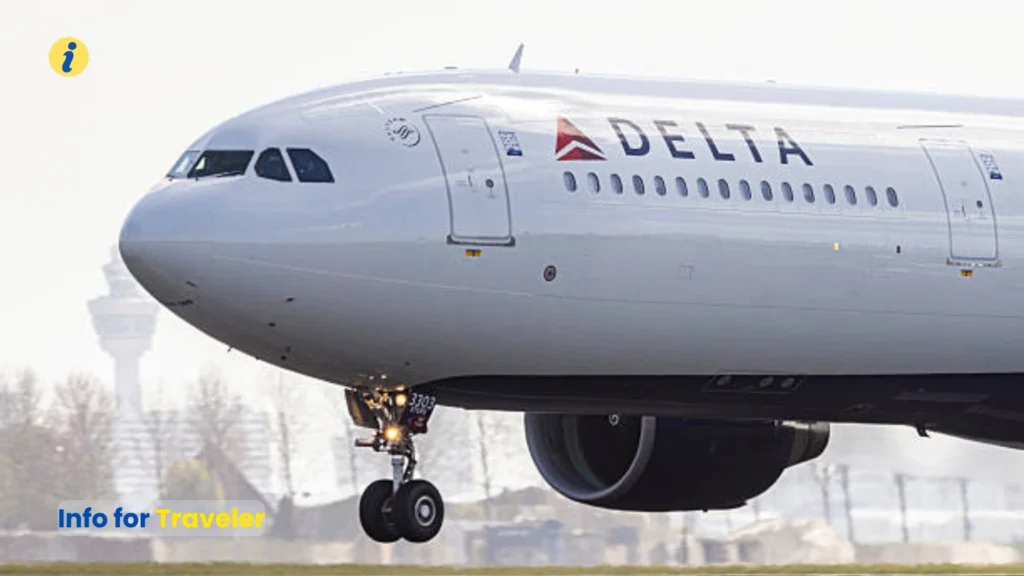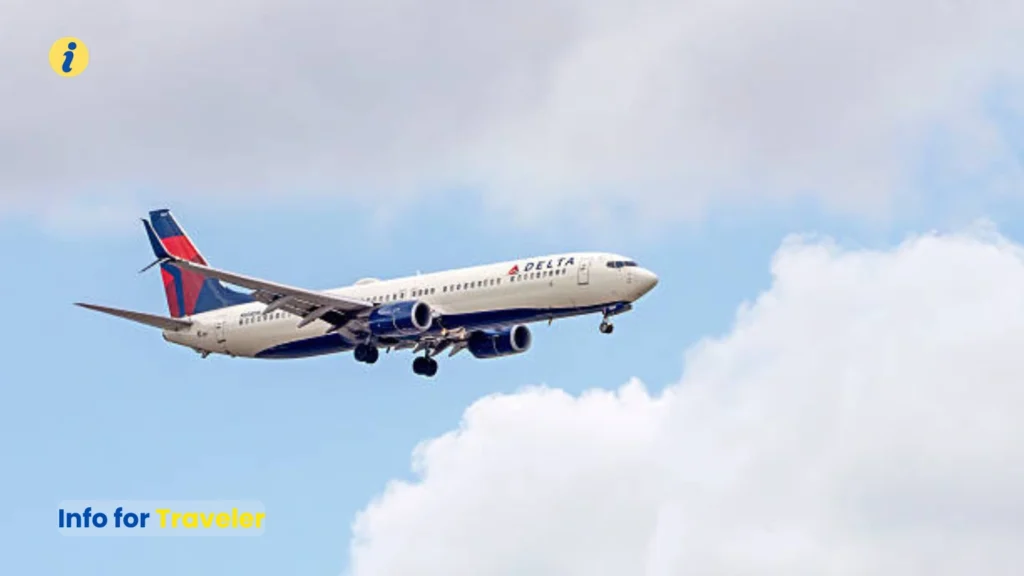Delta flight DL275 diverted LAX due to a critical engine anti-ice system failure on the Rolls-Royce Trent XWB engine during its Detroit to Tokyo route.
The delta flight DL275 diverted LAX incident occurred on May 28, 2025, when the Airbus A350-900 experienced a serious engine malfunction over the Bering Sea. This comprehensive analysis examines what happened during this high-stakes aviation emergency, how the crew responded, and what passengers experienced during the unexpected journey to Los Angeles International Airport.
Flight DL275 typically operates as a daily service from Detroit Metropolitan Wayne County Airport to Tokyo Haneda Airport. However, this particular flight became a case study in aviation safety protocols when the aircraft encountered technical difficulties that required immediate action. The delta flight tracker showed the aircraft making a dramatic course change approximately five hours into the 13-hour journey.
What Happened During the Delta Flight DL275 Diversion?
The diversion occurred when the aircraft’s Rolls-Royce Trent XWB engine experienced a complete anti-ice system malfunction while flying over the Bering Sea.
Delta flight DL275 departed Detroit’s gate A46 on schedule for what should have been a routine 13-hour flight to Tokyo Haneda Airport. The Airbus A350-900, with registration N508DN, was cruising at approximately 40,000 feet when pilots received warning indicators about the engine’s anti-ice system. This critical safety system prevents ice formation on engine components, which can cause catastrophic failure in cold, high-altitude conditions.
The flight crew immediately assessed the situation and determined that continuing to Tokyo would be unsafe. Given their position over the North Pacific, Los Angeles International Airport became the most suitable diversion destination. The dl275 diversion required the aircraft to fly for an additional five hours, bringing the total flight time to approximately 12 hours and 15 minutes.
Throughout this ordeal, the pilots maintained constant communication with air traffic control and Delta’s operations center. The decision to divert represented a textbook example of aviation safety protocols, where crew training and aircraft systems worked together to ensure passenger safety.
Delta Flight Status and Passenger Experience

All 280 passengers aboard delta flight dl275 remained safe throughout the emergency diversion, with flight attendants maintaining calm and providing regular updates.
When the diversion was announced, passengers initially experienced confusion and concern. Many had connecting flights in Tokyo or important business meetings scheduled. However, the professional response from the cabin crew helped maintain order throughout the unexpected journey. Flight attendants followed established emergency protocols, providing regular updates and ensuring passenger comfort during the extended flight time.
The dl275 flight status showed the aircraft maintaining stable flight conditions despite the engine issue. Modern aircraft like the Airbus A350 are designed to operate safely on one engine if necessary, though this wasn’t required in this case. The anti-ice system malfunction was serious enough to warrant diversion but didn’t compromise the aircraft’s ability to fly safely.
Passengers reported that the crew was transparent about the situation without causing unnecessary alarm. Regular announcements kept everyone informed about the diversion timeline and arrival procedures at LAX. The flight attendants also coordinated with ground staff to prepare for passenger rebooking and accommodation needs.
Technical Analysis of the Engine Anti-Ice System Failure
The Rolls-Royce Trent XWB engine’s anti-ice system failure posed significant safety risks, particularly given the aircraft’s high-altitude flight path over cold oceanic regions.
Aircraft anti-ice systems are crucial for preventing ice accumulation on critical engine components, especially the intake and fan blades. When flying at cruising altitude, outside air temperatures can drop to minus 60 degrees Celsius. Without functioning anti-ice systems, ice formation can disrupt airflow, damage engine components, or even cause complete engine failure.
The Trent XWB engines powering the A350 use hot air bleed from the engine compressor to keep critical surfaces ice-free. When this system malfunctions, pilots must either descend to warmer altitudes or divert to the nearest suitable airport. Given DL275’s position over the North Pacific, descending would have significantly increased fuel consumption and reduced range options.
Delta airlines maintenance teams later confirmed that the anti-ice system experienced a complete electrical failure, preventing the heated air distribution to critical engine surfaces. While the engine continued operating normally, the risk of ice-related damage made continuing the flight to Tokyo unacceptable under aviation safety standards.
Impact on Delta Operations and Cost Analysis
The delta flight dl275 diversion cost Delta Airlines approximately $2.3 million in fuel, crew overtime, passenger accommodations, and aircraft repositioning.
When a long-haul flight diverts, airlines face significant financial impacts beyond just the immediate operational costs. Delta had to arrange hotel accommodations for all 280 passengers, provide meal vouchers, and rebook travelers on alternative flights to Tokyo. Many passengers faced delays of 24 to 48 hours reaching their final destinations.
The aircraft required thorough inspection and repairs at LAX before returning to service. Delta’s maintenance team worked with Rolls-Royce engineers to diagnose and fix the anti-ice system failure. This process took approximately 36 hours, during which the aircraft remained grounded and unavailable for scheduled operations.
Additionally, Delta had to reposition another aircraft to maintain schedule integrity on the Detroit-Tokyo route. The delta 275 seat map shows the A350-900 configuration includes premium cabin classes, meaning the diversion affected high-value customers whose rebooking required significant accommodation efforts.
Aviation Safety Lessons and Industry Response
The incident highlighted the importance of robust safety protocols and crew training in managing complex emergency situations during long-haul flights.
Aviation safety experts praised the flight crew’s decision-making process and adherence to established protocols. The delta flight dl275 flight status throughout the emergency showed textbook execution of safety procedures. Rather than attempting to continue to Tokyo and risk potential engine damage, the crew prioritized passenger safety over schedule considerations.
The incident also sparked discussions about predictive maintenance technologies. Advanced analytics systems are being developed to detect potential component failures before they occur. If implemented, such systems might have identified the anti-ice system’s electrical issues during pre-flight checks or early in the flight.
Delta’s response to the incident became a case study for crisis management in the aviation industry. The airline’s transparent communication, efficient passenger rebooking, and comprehensive maintenance investigation demonstrated best practices for handling unexpected diversions.
Delta Flight Tracking and Modern Aviation Technology
Modern delta flight tracker systems provided real-time monitoring capabilities that helped coordinate the emergency response and keep stakeholders informed.
Flight tracking technology played a crucial role during the DL275 diversion. Air traffic controllers could monitor the aircraft’s position and progress in real-time, while Delta’s operations center maintained constant oversight of fuel consumption, weather conditions, and alternative airport options. These systems enabled coordinated decision-making throughout the emergency.
Passengers and their families could also follow the flight’s progress through various delta flight status platforms. This transparency helped reduce anxiety among those waiting for loved ones and demonstrated how modern aviation technology serves both operational and customer service needs.
The incident highlighted how integrated aviation systems work together during emergencies. From engine monitoring systems alerting pilots to potential problems, to air traffic control coordinating the diversion, to ground crews preparing for the unexpected arrival, technology enabled effective crisis management.
Long-term Implications for Delta and Airbus A350 Operations
The diversion prompted Delta to review maintenance protocols and enhanced collaboration with Rolls-Royce on engine reliability improvements.
Following the incident, Delta implemented additional pre-flight checks for Trent XWB engine anti-ice systems across its A350 fleet. The airline also enhanced crew training scenarios to include similar emergency situations, ensuring pilots and flight attendants maintain proficiency in handling complex diversions.
Airbus and Rolls-Royce conducted detailed investigations into the component failure, leading to improved diagnostic systems and preventive maintenance procedures. These enhancements benefit the entire A350 operator community and contribute to overall aviation safety improvements.
The delta flight dl275 arrival at LAX also demonstrated the airport’s capability to handle unexpected wide-body aircraft diversions. LAX emergency response teams performed efficiently, providing medical support, passenger services, and aircraft maintenance facilities on short notice.
Conclusion
The delta flight DL275 diverted LAX incident serves as an exemplary case study in modern aviation safety management. When faced with a critical engine system failure over the North Pacific, the flight crew demonstrated exceptional professionalism by prioritizing passenger safety over schedule adherence. The successful diversion to Los Angeles International Airport showcased the effectiveness of established emergency protocols and the reliability of modern aircraft systems.
This incident reinforces the importance of comprehensive crew training, robust maintenance procedures, and integrated safety systems in commercial aviation. While the diversion caused significant inconvenience and financial costs, the outcome validated decades of safety improvements in aircraft design, crew training, and operational procedures. Delta’s transparent handling of the situation and efficient passenger care further demonstrated industry best practices for crisis management.
The lessons learned from the DL275 diversion continue to influence aviation safety protocols and maintenance practices. As airlines increasingly rely on long-haul routes over remote oceanic areas, incidents like this provide valuable insights for improving safety systems and emergency response procedures. The aviation industry’s commitment to continuous improvement ensures that such experiences contribute to making air travel even safer for future passengers.
If you liked this well-researched breakthrough on DL275 Diverted LAX, you should check this amazing writing: To visit Vuzillfotsps, What to know about this Mystery
Frequently Asked Questions
What caused Delta flight DL275 to divert to LAX?
Delta flight DL275 diverted to LAX due to a complete failure of the Rolls-Royce Trent XWB engine’s anti-ice system, which posed safety risks during high-altitude flight over cold oceanic regions.
When did the Delta flight DL275 diversion occur?
The Delta flight DL275 diverted to LAX on May 28, 2025, approximately five hours into the scheduled Detroit to Tokyo Haneda flight.
How long did the diverted flight take to reach LAX?
The aircraft flew for approximately 12 hours and 15 minutes total, including 5 hours after the diversion decision was made over the Bering Sea.
Were any passengers injured during the DL275 diversion?
No passengers or crew members were injured during the Delta flight DL275 diversion. All 280 passengers remained safe throughout the emergency landing at LAX.
What is Delta’s flight DL275 normal route and schedule?
Delta flight DL275 operates daily from Detroit Metropolitan Wayne County Airport (DTW) to Tokyo Haneda Airport (HND), with a scheduled flight time of 13 hours and 20 minutes.
Is Delta a good airline to fly for international routes?
Delta consistently ranks among the top U.S. carriers for international service, offering extensive route networks, modern aircraft, and comprehensive safety protocols as demonstrated in the DL275 incident.
What plane was involved in the Delta DL275 diversion?
The incident involved an Airbus A350-900 with registration N508DN, powered by Rolls-Royce Trent XWB engines and configured according to Delta 275 seat map specifications.
How much did the DL275 diversion cost Delta Airlines?
Industry analysis estimates the Delta flight DL275 diversion cost approximately $2.3 million, including fuel, passenger accommodations, crew overtime, and aircraft repositioning.
What is a Delta pilot’s salary for long-haul flights?
Delta pilots operating long-haul international flights like DL275 typically earn between $200,000 to $350,000 annually, depending on experience and aircraft type certification.
How can passengers track Delta flight status in real-time?
Passengers can monitor DL275 flight status and other Delta flights using the airline’s official app, website, or third-party services like FlightAware and FlightRadar24.
What country manufactures Delta’s A350 aircraft?
Delta’s Airbus A350 aircraft are manufactured in France and Germany, with final assembly taking place at Airbus facilities in Toulouse, France.










